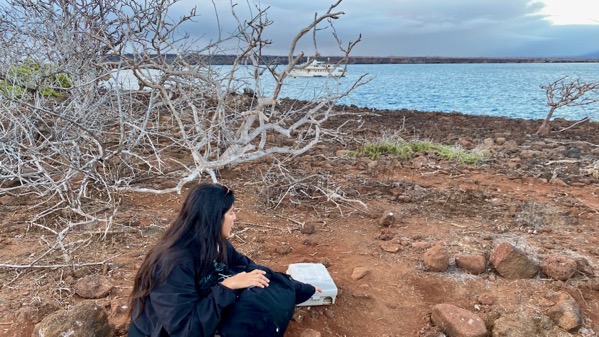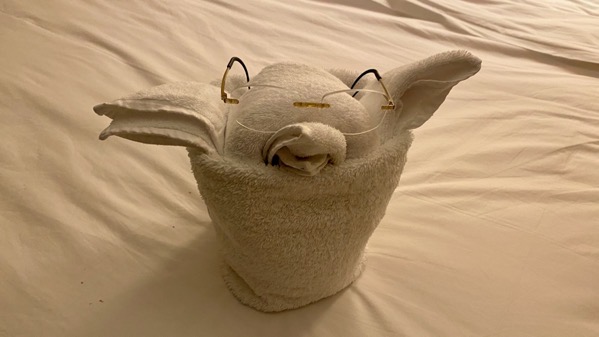North and west
Sunday, 17 July 2022

We traveled overnight, and boarded pangas starting at 6am to walk on North Seymour Island. The park regulations say that no one can be on land between 8pm and 8am. They require overnight ship passengers are only on land until 10am and after 3pm. The day-trippers get the hot, bright hours in between when many of the animals are far less active. I checked and this photo was at 6:07am, just after we started walking. Pretty sure these are frigate birds.

Sofia is discussing rat problems. The trap has low-level sulfur in it, enough to kill the rat after a time, and not enough that a hawk will sicken from eating it. Rats are of course introduced, and a problem along with goats, dogs, cats, and at least one insect, all causing significant problems.

Call this a frigate bird condo. Frigate birds don’t need much personal space, as you can tell, so the gents try to build their nests in the best trees, to catch a lady frigate bird. The red sacs take perhaps twenty minutes to inflate or deflate. They attract lady frigates to check out nest quality. If the latter meets spec, they will stay and mate.

Frigates pairing up.

Beautiful morning rainbow omen.

If I have it right, the Galápagos islands were stripped of this lichen at one time, to sell for making a purple dye. Lichens are of course slow-growing, so it has taken many decades for them to return.

Land iguana.

Posing bird. I’m anthropomorphizing.

See the two islands? Those are the Daphnes, with Daphne Major to the left, and Daphne Minor to the right. The famous forty-year study of finches by the Grants was on Daphne Major. Others have continued studies. Check out “The Beak of the Finch: A Story of Evolution in Our Time” by Jonathan Weiner if you’re interested.
On land you can see pairs of white stakes. We only walk between them.

When the booby parent comes back from fishing, the booby baby (technical naturalist term), bangs beaks with the parent. This eventually stimulates the parental bird to regurgitate. The chick sticks its head down the parental throat to get the food.
Aren’t you glad this isn’t the human style.
Back aboard, the Grace got underway and we had breakfast, then most of us watched two very well-made videos, one on Darwin and Wallace, and one on von Humboldt. The latter was a contemporary of Thomas Jefferson, and probably the first person you could consider a modern naturalist, at least in the Western world. I’m going to hunt up a copy of Wulf’s “The Invention of Nature: Alexander von Humboldt’s New World” to read up on this fascinating man and how he laid the groundwork for his successors.
Next, we had a lovely snorkel followed by a late lunch, if I have it right. Or perhaps the snorkel was after lunch? I forgot to record some details.

Our late-day panga trip located, tada!, penguins. The only tropical penguins. Soooo wonderful.

This is a dry landing on Bartolomé. Many other ships in this area.

Bartolomé has a boardwalk, only it’s mostly steps. It goes to the top. We made many photos in the late-day sun.

Note the many cinder cones. Sooooo different from every other island we’ve visited.

When we return after our afternoon excursions, we are greeted by a critter. I think this is a towel owl, a short-eared owl, yet, oddly wearing (my) spectacles. Teehee. John says its a baby Yoda.